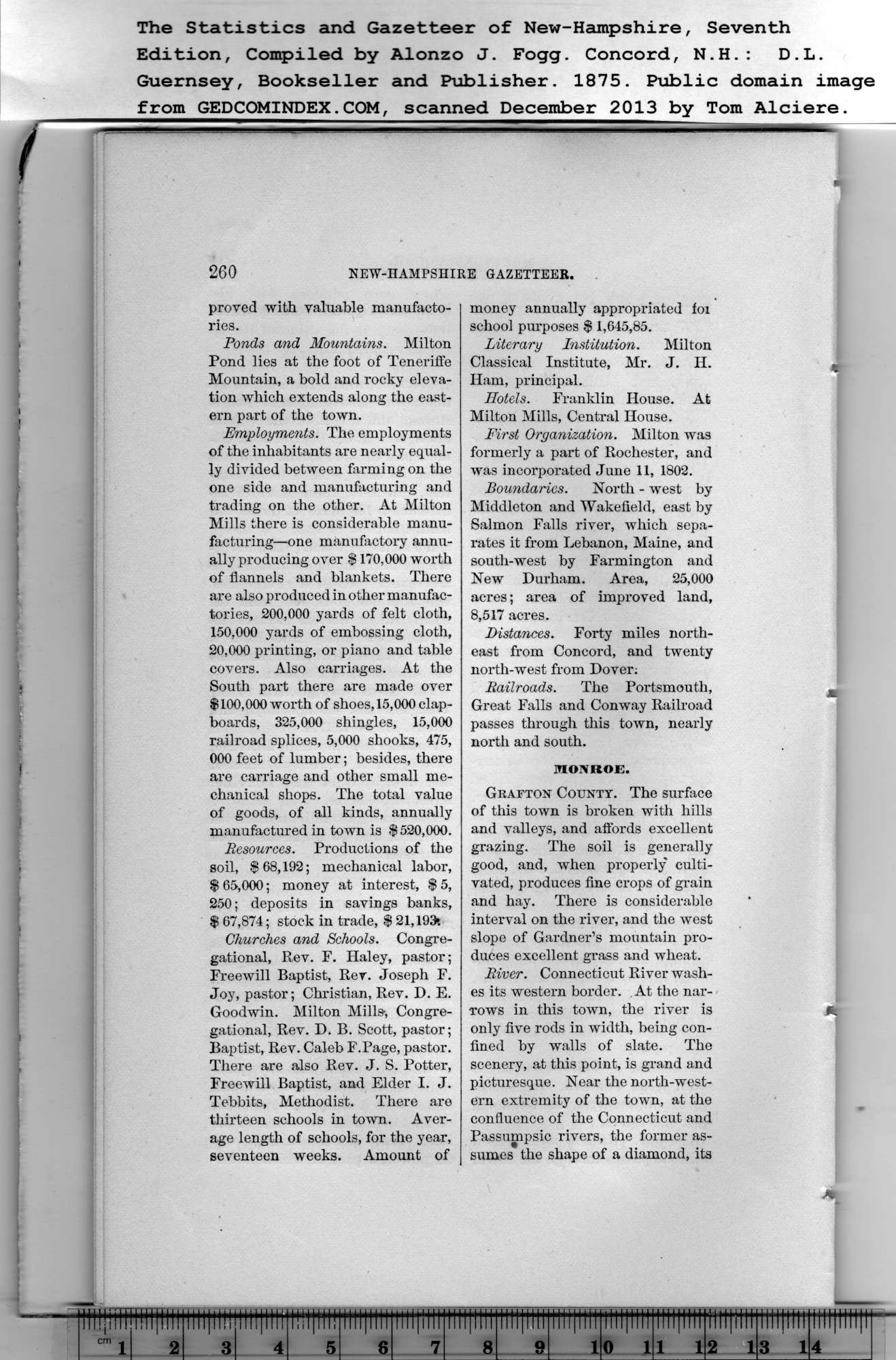|
proved with valuable manufacto-
ries.
Ponds and Mountains. Milton
Pond lies at the foot of Teneriffe
Mountain, a bold and rocky eleva-
tion which extends along the east-
ern part of the town.
Employments. The employments
of the inhabitants are nearly equal-
ly divided between farming on the
one side and manufacturing and
trading on the other. At Milton
Mills there is considerable manu-
facturing—one manufactory annu-
ally producing over $ 170,000 worth
of flannels and blankets. There
are also produced in other manufac-
tories, 200,000 yards of felt cloth,
150.000 yards of embossing cloth,
20.000 printing, or piano and table
covers. Also carriages. At the
South part there are made over
$100,000 worth of shoes, 15,000 clap-
boards, 325,000 shingles, 15,000
railroad splices, 5,000 shooks, 475,
000 feet of lumber; besides, there
are carriage and other small me-
chanical shops. The total value
of goods, of all kinds, annually
manufactured in town is $ 520,000.
Resources. Productions of the
soil, $68,192; mechanical labor,
$ 65,000; money at interest, $ 5,
250; deposits in savings banks,
$ 67,874; stock in trade, $ 21,193*.
Churches and Schools. Congre-
gational, Rev. F. Haley, pastor;
Freewill Baptist, Rev. Joseph F.
Joy, pastor; Christian, Rev. D. E.
Goodwin. Milton Mills-, Congre-
gational, Rev. D. B. Scott, pastor;
Baptist, Rev. Caleb F.Page, pastor.
There are also Rev. J. S. Potter,
Freewill Baptist, and Elder I. J.
Tebbits, Methodist. There are
thirteen schools in town. Aver-
age length of schools, for the year,
seventeen weeks. Amount of
money annually appropriated foi
school purposes $ 1,645,85. |
Literary Institution. Milton
Classical Institute, Mr. J. H.
Ham, principal.
Hotels. Franklin House. At
Milton Mills, Central House.
First Organization. Milton was
formerly a part of Rochester, and
was incorporated June 11, 1802.
Boundaries. North - west by
Middleton and Wakefield, east by
Salmon Falls rivei-, which sepa-
rates it from Lebanon, Maine, and
south-west by Farmington and
New Durham. Area, 25,000
acres; area of improved land,
8,517 acres.
Distances. Forty miles north-
east from Concord, and twenty
north-west from Dover:
Railroads. The Portsmouth,
Great Falls and Conway Railroad
passes through this town, nearly
north and south.
MONROE.
Grafton County. The surface
of this town is broken with hills
and valleys, and affords excellent
grazing. The soil is generally
good, and, when properly culti-
vated, produces fine crops of grain
and hay. There is considerable
interval on the river, and the west
slope of Gardner’s mountain pro-
duces excellent grass and wheat.
River. Connecticut River wash-
es its western border. . At the nar-
rows in this town, the river is
only five rods in width, being con-
fined by walls of slate. The
scenery, at this point, is grand and
picturesque. Near the north-west-
ern extremity of the town, at the
confluence of the Connecticut and
Passumpsic rivers, the former as-
sumes the shape of a diamond, its |
